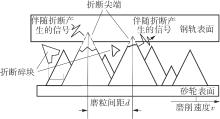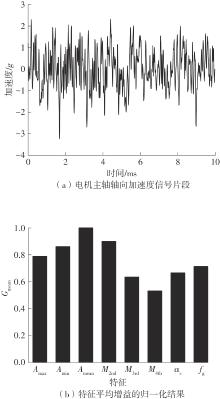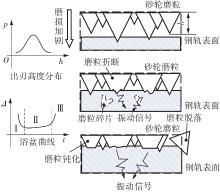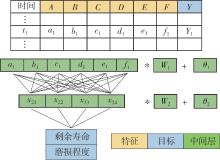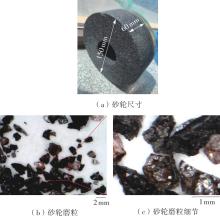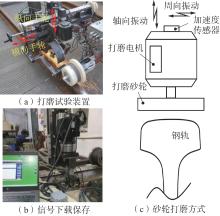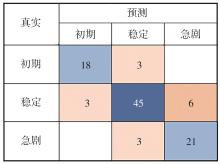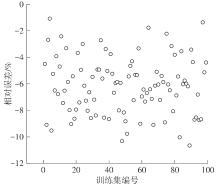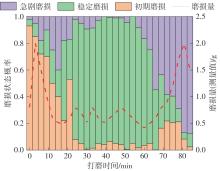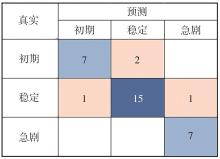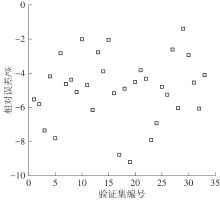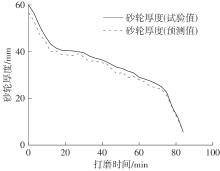Journal of South China University of Technology(Natural Science Edition) ›› 2025, Vol. 53 ›› Issue (4): 72-80.doi: 10.12141/j.issn.1000-565X.240173
• Mechanical Engineering • Previous Articles Next Articles
Wear Evaluation and Residual Life Prediction Method for Rail Grinding Wheels
HE Zhe, ZHANG Yuying, LIU Shangkun, GAO Chunlei
- State Key Laboratory for Track System of High-Speed Railway/Railway Engineering Research Institute/China Academy of Railway Sciences Corporation Limited,Beijing 100081,China
-
Received:2024-04-10Online:2025-04-25Published:2024-07-23 -
About author:何喆(1992—),男,博士,副研究员,主要从事钢轨打磨研究。E-mail: hz_cars@163.com -
Supported by:the National Natural Science Foundation of China(52005029)
CLC Number:
Cite this article
HE Zhe, ZHANG Yuying, LIU Shangkun, GAO Chunlei. Wear Evaluation and Residual Life Prediction Method for Rail Grinding Wheels[J]. Journal of South China University of Technology(Natural Science Edition), 2025, 53(4): 72-80.
share this article
| 1 | 吴泽宇,李明航,王文斌,等 .车轮踏面粗糙度对基于惯性基准法的钢轨波磨检测结果影响分析[J].振动与冲击,2023,42(15):241-249. |
| WU Zeyu, LI Minghang, WANG Wenbin,et al .Influence analysis of wheel tread roughness on rail corrugation detection results based on inertial reference method[J].Journal of Vibration and Shock,2023,42(15):241-249. | |
| 2 | 张胜,刘长宝,樊小强,等 .固化工艺对树脂基高速打磨磨石性能影响[J].铁道学报,2024,46(1):137-144. |
| ZHANG Sheng, LIU Changbao, FAN Xiaoqiang,et al .Effect of curing process on properties of resin based high speed grinding wheel and its regulation mechanism[J].Journal of the China Railway Society,2024,46(1):137-144. | |
| 3 | 李江,樊文刚,吴志伟,等 .基于槽型接触轮的钢轨砂带打磨材料去除特性[J].中国铁道科学,2023,44(4):75-83. |
| LI Jiang, FAN Wengang, WU Zhiwei,et al .Research on material removal characteristics of rail grinding by abrasive belt based on grooved contact wheel[J].China Railway Science,2023,44(4):75-83. | |
| 4 | HE Z, LI J Y, LIU Y M,et al .Investigation of conditions leading to critical transitions between abrasive belt wear modes for rail grinding[J].Wear,2021,484/485:204048/1-9. |
| 5 | 樊文刚,刘月明,李建勇 .高速铁路钢轨打磨技术的发展现状与展望[J].机械工程学报,2018,54(22):184-195. |
| FAN Wengang, LIU Yueming, LI Jianyong .Development status and prospect of rail grinding technology for high speed railway[J].Journal of Mechanical Engineering,2018,54(22):184-195. | |
| 6 | D’ADDONA D M, MATARAZZO D, TETI R,et al .Prediction of dressing in grinding operation via neural networks[J].Procedia CIRP,2017,62:305-310. |
| 7 | GONZÁLEZ D, ALVAREZ J, SÁNCHEZ J,et al .Deep learning-based feature extraction of acoustic emission signals for monitoring wear of grinding wheels[J].Sensors,2022,22:6911/1-14. |
| 8 | 张诗语 .SiCf/SiC复合材料磨削中基于声发射信号的砂轮磨损识别[D].长沙:湖南大学,2022. |
| 9 | 胡天荣,郑红伟,戴士杰 .基于异类信息融合的砂轮磨损状态监测[J].工具技术,2023,57(2):126 -131. |
| HU Tianrong, ZHENG Hongwei, DAI Shijie .Grinding wheel wear condition monitoring based on heterogeneous information fusion[J].Tool Engineering,2023,57(2):126 -131. | |
| 10 | BI G, LIU S, SU S B,et al .Diamond grinding wheel condition monitoring based on acoustic emission signals[J].Sensors,2021,21(4):1054/1-17. |
| 11 | 于帅 .基于钢轨打磨车的砂带磨损监测系统研究[D].北京:北京交通大学,2021. |
| 12 | 程灿,李建勇,刘月明,等 .基于磨削声与电流的砂带磨损状态识别[J].振动、测试与诊断,2020,40(2):355-360,422. |
| CHENG Can, LI Jianyong, LIU Yueming,et al .Wear identification of abrasive belt based on grinding sound and current[J].Journal of Vibration,Measurement and Diagnosis,2020,40(2):355-360,422. | |
| 13 | 毛聪,孙鹏程,唐伟东,等 .磨削白层特性及其与声发射信号的相关性[J].机械工程学报,2023,59(9):349-359. |
| MAO Cong, SUN Pengcheng, TANG Weidong,et al .Features of grinding white layer and its correlation with acoustic emission signal[J].Journal of Mechanical Engineering,2023,59(9):349-359. | |
| 14 | 赵华东,刘勇,朱振伟,等 .金刚石砂轮与金刚石滚轮磨削接触的声发射监测[J].机械设计与制造,2024(2):174-178. |
| ZHAO Hua-dong, LIU Yong, ZHU Zhen-wei,et al .Acoustic emission monitoring of grinding contact between diamond wheel and diamond wheel[J].Machi-nery Design & Manufacture,2024(2):174-178. | |
| 15 | 何喆,李建勇,刘月明,等 .砂带虚拟形貌的建模[J].华南理工大学学报(自然科学版),2017,45(12):85-91,105. |
| HE Zhe, LI Jian-yong, LIU Yue-ming,et al .Modeling of virtual topography of abrasive belt[J].Journal of South China University of Technology (Natural Science Edition),2017,45(12):85-91,105. | |
| 16 | 程灿 .面向钢轨打磨的砂带磨损状态监测与剩余寿命预测研究[D].北京:北京交通大学,2020. |
| 17 | 聂磊,张吕凡,徐诗奕,等 .基于相似度特征融合和CNN的滚动轴承剩余寿命预测[J].噪声与振动控制,2023,43(5):115-121. |
| NIE Lei, ZHANG Lvfan, XU Shiyi,et al .Remaining life prediction of rolling bearing based on similarity feature fusion and convolutional neural network[J].Noise and Vibration Control,2023,43(5):115-121. | |
| 18 | 刘岚,侯立群 .基于改进一维残差网络的轴承故障诊断[J].仪器仪表用户,2021,28(9):45-50. |
| LIU Lan, HOU Liqun .Bearing fault diagnosis method based on improved 1D residual network[J].Instrumentation,2021,28(9):45-50. | |
| 19 | 张国文,贺春江,张静,等 .钢轨打磨车砂轮技术标准[J].金刚石与磨料磨具工程,2018,38(4):83-86. |
| ZHANG Guowen, HE Chunjiang, ZHANG Jing,et al .Standard of grinding wheel used on rail grinding[J].Diamond and Abrasives Engineering,2018,38(4):83-86. | |
| 20 | 钢轨打磨车砂轮订货技术条件: [S]. |
| 21 | 谭永敏,施展,迟玉伦,等 .基于Shannon熵与声发射信号的CBN砂轮性能监测方法研究[J].机械强度,2023,45(2):321-330. |
| TAN Yongmin, SHI Zhan, CHI Yulun,et al .Research on CBN grinding wheel performance monitoring method based on Shannon entropy and acoustic emission signal[J].Journal of Mechanical Strength,2023,45(2):321-330. | |
| 22 | 赵书东,禹晓敏,王文玺,等 .金字塔砂带磨损状态的声信号GA-BP识别方法[J].表面技术,2024,53(3):28-38. |
| ZHAO Shudong, YU Xiaomin, WANG Wenxi,et al .GA-BP identification of acoustic signals for wear states of pyramidal abrasive belts[J].Surface Technology,2024,53(3):28-38. | |
| 23 | 黄献聪,来悦,李常胜,等 .超高分子量聚乙烯纤维及其复合材料的热氧老化行为[J].兵工学报,2022,43(12):3211-3220. |
| HUANG Xiancong, LAI Yue, LI Changsheng,et al .Thermo-oxidative aging behavior of ultra-high molecular weight polyethylene fiber and its composites[J].Acta Armamentarh,2022,43(12):3211-3220. | |
| 24 | 樊威,李嘉禄 .热氧老化对碳纤维织物增强聚合物基复合材料弯曲性能的影响[J].复合材料学报,2015,32(5):1260-1270. |
| FAN Wei, LI Jialu .Effects of thermo-oxidative aging on flexural properties of carbon fiber fabric reinforced polymer matrix composites[J].Acta Materiae Compositae Sinica,2015,32 (5):1260-1270. |
| [1] | CAO Ruifen, HU Weiling, LI Qiangsheng, BIN Yannan, ZHENG Chunhou. Prediction Method of IL-6 Inducing Peptides Based on Graph Neural Network [J]. Journal of South China University of Technology(Natural Science Edition), 2025, 53(5): 109-117. |
| [2] | DAI Zhou, LIU Yan, MAO Xianyin, GUO Tao, XU Lianggang, CHENG Guixian. Fusion Transformer Model-Based Segmentation Algorithm for Laser Point Cloud of Distribution Lines [J]. Journal of South China University of Technology(Natural Science Edition), 2025, 53(5): 139-146. |
| [3] | HU Guanghua, DAI Zhigang, WANG Qinghui. Machining Feature Recognition Method of B-Rep Model Based on Graph Neural Network [J]. Journal of South China University of Technology(Natural Science Edition), 2025, 53(5): 20-31. |
| [4] | JIA Huayu, ZHENG Huilong, ZHOU Hong, ZHANG Qian. Optimal Selection of UAV Launch Parameters Based on SSA-BP Neural Network [J]. Journal of South China University of Technology(Natural Science Edition), 2025, 53(4): 90-101. |
| [5] | BI Jun, WANG Jianing, WANG Yongxing. Short-Term Operation State Prediction of Charging Station Based on LSTM-FC Model [J]. Journal of South China University of Technology(Natural Science Edition), 2025, 53(2): 58-67. |
| [6] | DU Qiliang, WANG Yimin, TIAN Lianfang. Attention Module Based on Feature Similarity and Feature Normalization [J]. Journal of South China University of Technology(Natural Science Edition), 2024, 52(7): 62-71. |
| [7] | LIU Weirong, ZHANG Zhiqiang, ZHANG Ning, et al. A TT-Tucker Decomposition-Based LC Convolutional Neural Network Compression Method Without Pre-Training [J]. Journal of South China University of Technology(Natural Science Edition), 2024, 52(7): 29-38. |
| [8] | YUAN Renteng, WANG Chenzhu, XIANG Qiaojun, et al. Trajectory Data-Driven Model for Vehicle Lane Change Intention Recognition [J]. Journal of South China University of Technology(Natural Science Edition), 2024, 52(6): 34-44. |
| [9] | CAI Xiaodong, ZHOU Qingsong, YE Qing. Social Recommendation Model Based on Dynamic Neighborhood Sampling [J]. Journal of South China University of Technology(Natural Science Edition), 2024, 52(2): 32-41. |
| [10] | ZHU Rui, LIU Yu, LIANG Yuying, et al. BP Neural Network Prediction Model for Turbulent Noise Intensity in Gas/Water Medium [J]. Journal of South China University of Technology(Natural Science Edition), 2024, 52(12): 119-126. |
| [11] | QIANG Xuhong, TIAN Weixiao, JIANG Xu, et al. Intelligent Method for Identifying Damage of Steel Members with Localized Random Pitting Based on Convolutional Neural Network [J]. Journal of South China University of Technology(Natural Science Edition), 2024, 52(11): 43-54. |
| [12] | YANG Chunling, CHEN Wenjun, LIU Jiahui. Feature-Space Optimization-Inspired and Multi-Hypothesis Cross-Attention Reconstruction Neural Network for Video Compressive Sensing [J]. Journal of South China University of Technology(Natural Science Edition), 2024, 52(10): 9-21. |
| [13] | FANG Gang, YUAN Longhua, WANG Xiaoming, et al. Soft-Sensor Modeling Method Based on Ensemble Kalman Filter-Elman Neural Network [J]. Journal of South China University of Technology(Natural Science Edition), 2023, 51(8): 126-136. |
| [14] | MA Xiaoliang, AN Lingling, DENG Congjian, et al. Translation Optimization Technology of Automatic Speech Recognition Based on Industry-Specific Vocabulary [J]. Journal of South China University of Technology(Natural Science Edition), 2023, 51(8): 118-125. |
| [15] | ZHU Zhengyu, LUO Chao, HE Qianhua, et al. Multi-View Lip Motion and Voice Consistency Judgment Based on Lip Reconstruction and Three-Dimensional Coupled CNN [J]. Journal of South China University of Technology(Natural Science Edition), 2023, 51(5): 70-77. |
| Viewed | ||||||
|
Full text |
|
|||||
|
Abstract |
|
|||||
